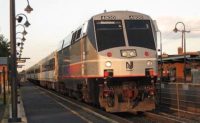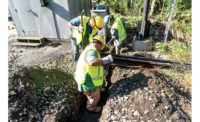The $71-billion commuter rail industry claims to be running at full throttle to fully implement positive train control (PTC) systems by a 2020 federally mandated deadline, but while officials say all of the nation’s systems have completed hardware and software installations, they admit that many implementation challenges still exist.
PTC systems are being installed to prevent trains from collisions and excessive speeding. The National Transportation Safety Board identified the lack of such systems as a significant safety problem. NTSB blamed track owner Sound Transit for failure to implement PTC on a dangerous curve near DuPont, Wash., where a 2017 Amtrak derailment killed three passengers and injured 57 people.
Narayana Sundaram, senior director of engineering and commuter rail operations for the American Public Transportation Association says, “What is being done, and will be done, is testing and certification of the systems nationwide.”
APTA is the only association in North America that represents all modes of public transportation.
“The commuter rail industry is 100% committed to meeting the deadline and does not anticipate an extension,” Sundaram says. “The entire commuter industry has been tirelessly working to develop, test, install, and customize PTC for every single system. The industry has committed billions of dollars and countless hours to getting it done.”
The steps to certification by the Federal Railway Administration include successfully operating PTC on all miles of eligible track, applying for FRA approval, and achieving interoperability, Sundaram says, but the obstacles are many and varied and involve extensive testing for component reliability. “It is incumbent on the industry, FRA and APTA to work together to ensure that railroads can meet these statutory requirements,” Sundaram says.
“All railroads have successfully tested PTC in the lab as well as in the field. PTC testing includes lab testing, field testing, revenue service demonstration, and then ultimately interoperability testing before certification takes place,” Sundaram says.
Four railroads have fully implemented PTC and have been approved by the FRA: Metrolink (Southern California), NCTD (North San Diego County), TriMet (Portland, Ore.) and PATH (New York and New Jersey), Sundaram says.
One of the difficulties of fully implementing PTC starts with selecting which of the four variant systems that meet FRA standards will work best with a given commuter rail operation.
“The choice is dependent on a lot of factors,” says Sundaram. Those include whether the commuter rail system needs to be interoperable with other rail systems, whether high-speed operations are involved, and what its existing signal systems are, among other factors. “All system variants existing today have received design approval (“type approval”) from FRA to provide an initial assurance of system functionality,” he said.
The implementation details are then handled by the railroads.
Doug Woodbury, rail systems manager for HNTB, with 30 years' experience as a project manager and project engineer for various companies. He believes that railroads are concentrating now on the 2020 deadline, but after then, improvements will enter a new phase.
“For most railroads, it (PTC) is still a work in progress,” says Doug Woodbury, rail systems manager for HNTB. He says the challenge has been getting enough technical expertise while, at the same time, trying to develop additional ways to keep rail systems in service while the work is being done.
Woodbury said the focus as the 2020 deadline approaches is going to be on testing of the equipment. “Crews are going out every night and going over trains and making sure they respond correctly,” Woodbury said. “They are still finding issues with some of the equipment, primarily software-related, and [those are] then being brought back to vendors.
He says there are side lessons being learned during PTC installation. "If anything, the installation of PTC showed the need to update rail service nationwide and [it] gave railroads a chance to make other needed upgrades," Woodbury says. He notes that some states that might have been reluctant to shut down rails before the PTC mandate, now “are taking advantage to get other projects done at the same time.”
"They say 'hey, I need to shut down anyway so I can repair bridges and various other things — it’s using the same opportunity,” Woodbury says. He adds, though that “another phase” of new work may appear after the rail work is complete because “PTC protection stops before you get into that terminal,” he said.
The discussion for engineers now has turned to looking at accidents within terminal stations, he says, pointing to a 2018 incident at the Hoboken station in New Jersey where a train crashed into a terminal, killing one.
“The discussion now is that PTC isn’t implemented into terminal areas. Trains are already operating through there and generally are limited to 15 mph, and the thinking is that any incidents should be less severe. But, even one fatality is too severe. The thinking now is less of accident and more [of the] technical complexity to stop it," he said.
However, despite the goal of achieving safer railway operations, the installation process has angered commuters in many places. In New Jersey, service disruptions during the work have added to an already tarnished image of the state’s commuter rail system.
Trains that run across New Jersey to connect the Atlantic City casino resort with Philadelphia’s transit hub saw a delay of more than half of a year longer than expected, angering commuters and officials because of potential damage to the resort economy. The trains resumed in May but New Jersey riders have complained since 2018 about station closings and delays in transit to New York City as well.
“It’s unbelievable to me NJ Transit would pay over $700,000 for an expert plan to increase ridership, only to do the opposite and then wonder why fewer people are riding the train. Once again, NJ Transit is off the rails and short-changing our local families and businesses by not providing our fair share of services,” said state Sen. Chris Brown (R) in a statement.
In Boston, the PTC project manager reported problems with both hardware and software — and the company behind the technology, Siemens, is sending a team to Boston to examine the $459-million project that is expected to be operational by 2020. New York also is threatening to cut off business with Siemens over similar issues.
Sundaram says riders need to stay current on PTC as 2020 approaches. Shutdowns of rail lines were not a choice, but a necessity, he adds. PTC installation, testing and certification, has required railroads to taken tracks and rolling stock out of service, communicate service impacts to their customers, which ends up costing revenue in an already tight budgetary environment.
“This has necessitated railroads to make significant service adjustments. Each commuter rail agency has done its best to continue serving its customers throughout the installation of PTC," Sundaram said.
There’s also a concern whether the PTC installation delays have caused a perception problem with riders. However, Sundaram said transit riders need to focus on the reality of the situation.
“Just like work zones on a highway can cause traffic delays, so too, have some public transit riders experienced delays as PTC has been installed in their commuter rail system,” Sundaram says.
“Commuter railroads typically operate in a very densely populated environment. This has necessitated railroads to make significant service adjustments. We urge riders to be patient and understand that PTC will make an already safe system even safer,” Sundaram says.



Post a comment to this article
Report Abusive Comment